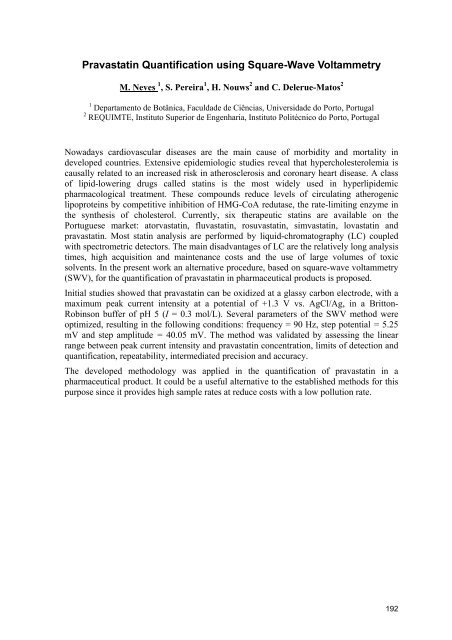IJUP08 - Universidade do Porto
IJUP08 - Universidade do Porto
IJUP08 - Universidade do Porto
- TAGS
- universidade
- porto
- ijup.up.pt
Create successful ePaper yourself
Turn your PDF publications into a flip-book with our unique Google optimized e-Paper software.
Pravastatin Quantification using Square-Wave Voltammetry<br />
M. Neves 1 , S. Pereira 1 , H. Nouws 2 and C. Delerue-Matos 2<br />
1 Departamento de Botânica, Faculdade de Ciências, <strong>Universidade</strong> <strong>do</strong> <strong>Porto</strong>, Portugal<br />
2 REQUIMTE, Instituto Superior de Engenharia, Instituto Politécnico <strong>do</strong> <strong>Porto</strong>, Portugal<br />
Nowadays cardiovascular diseases are the main cause of morbidity and mortality in<br />
developed countries. Extensive epidemiologic studies reveal that hypercholesterolemia is<br />
causally related to an increased risk in atherosclerosis and coronary heart disease. A class<br />
of lipid-lowering drugs called statins is the most widely used in hyperlipidemic<br />
pharmacological treatment. These compounds reduce levels of circulating atherogenic<br />
lipoproteins by competitive inhibition of HMG-CoA redutase, the rate-limiting enzyme in<br />
the synthesis of cholesterol. Currently, six therapeutic statins are available on the<br />
Portuguese market: atorvastatin, fluvastatin, rosuvastatin, simvastatin, lovastatin and<br />
pravastatin. Most statin analysis are performed by liquid-chromatography (LC) coupled<br />
with spectrometric detectors. The main disadvantages of LC are the relatively long analysis<br />
times, high acquisition and maintenance costs and the use of large volumes of toxic<br />
solvents. In the present work an alternative procedure, based on square-wave voltammetry<br />
(SWV), for the quantification of pravastatin in pharmaceutical products is proposed.<br />
Initial studies showed that pravastatin can be oxidized at a glassy carbon electrode, with a<br />
maximum peak current intensity at a potential of +1.3 V vs. AgCl/Ag, in a Britton-<br />
Robinson buffer of pH 5 (I = 0.3 mol/L). Several parameters of the SWV method were<br />
optimized, resulting in the following conditions: frequency = 90 Hz, step potential = 5.25<br />
mV and step amplitude = 40.05 mV. The method was validated by assessing the linear<br />
range between peak current intensity and pravastatin concentration, limits of detection and<br />
quantification, repeatability, intermediated precision and accuracy.<br />
The developed metho<strong>do</strong>logy was applied in the quantification of pravastatin in a<br />
pharmaceutical product. It could be a useful alternative to the established methods for this<br />
purpose since it provides high sample rates at reduce costs with a low pollution rate.<br />
192










